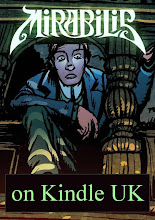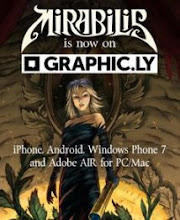 When early filmgoers saw the first close-ups on there on the big screen, many were baffled. “What is this giant face?” they wondered. And, “Why did you show a man looking horrified and then cut to a new image of a baby's pram bouncing down some steps? Is there supposed to be a connection?”
When early filmgoers saw the first close-ups on there on the big screen, many were baffled. “What is this giant face?” they wondered. And, “Why did you show a man looking horrified and then cut to a new image of a baby's pram bouncing down some steps? Is there supposed to be a connection?”Cinematic storytelling. The grammar of moving images. It didn’t take long for audiences to learn the rules. Or to discover how they work, I should say, because visual grammar is like linguistic grammar: it’s wired into us as the way we process the world.
One hundred and ten years on from the birth of cinema, everyone on the planet understands how to read a montage of images. Take this example from a recent Virgin Atlantic commercial. The camera starts by showing us a man in a crowd on a mobile phone. He looks up, gradually loses interest in the call. He’s staring. The phone slips from his fingers. Cut to a low-angle reverse shot, past his legs, as the phone breaks on the floor and we get a glimpse of a bunch of air stewardesses walking into shot. And we cut to a shot of the air stewardesses walking towards us, and we see that the man is gawking because they’re really hot.
The sequence there uses both suspense (what is the man reacting to?) and empathy/identification (look – this is how you are meant to react). It’s good storytelling because starting on the girls themselves would give us something to react to but no character to ground our empathy. Crucially, what makes it good cinematic storytelling is that the meaning comes from the whole sequence of images. There is no “telling”. Each image is a single brick; it’s only the whole that has to look like a house.
Nobody at the ad agency seems to have thought that a classic Eisenstein montage like that risked confusing the viewers. “Maybe it needs a voiceover saying that if you fly Virgin Atlantic you might get to chat up a sexy stewardess?” Nah. The images already tell the story. Irving the Explainer isn’t going to add anything.
So it surprises me that many people are unable to extract meaning from a comic story unless there are plenty of captions and word balloons (lots of text, in other words) to carry them along. Yet you can perfectly well “read” a classic sequence like the opening five pages of Spider-man #33 without looking at the words. Or look at this page of the Tintin story Black Island (analysed in depth here on Peter Richardson’s excellent Cloud 109 blog). You don’t need to speak one word of French to understand what’s going on.
Comics are not movies. But their great strength is that they can use cinematic grammar as well as literary grammar. The reason many people find it difficult to read a comic visually is, I think, because of the way they see comics. Rather than taking the comic as a montage of images and words combined to tell a story, they think of the comic as a kind of illustrated novel. In books at primary school, you might have an image of a big guy in chains rising up from behind a gravestone to terrify a little kid, and the caption would read, “Magwitch surprises Pip in the churchyard”. If you come to a comic with that preconception, you won’t expect the pictures to tell the story, you’ll just expect them to illustrate what the words have already told you.
This may be a particular problem in the UK, where we have no mainstream tradition of comics storytelling and our movies are mostly televisual rather than cinematic. So British audiences are accustomed to having the words carry the story, and any images are just there as eye candy. Well, Britain is just one island (actually it’s around a thousand, including the Outer Hebrides, but only one and a half big ones) so it wouldn't matter that much if the British never get hip to comics. Europe, India, the USA, Japan and Korea add up to a pretty big market to be going on with. Yet I do find it a shame that most of my British friends, unless they were reared on American comic books as I was, are not able to appreciate le neuvième art. So I can’t share my love of Sandman or Watchmen or B.P.R.D. with them, much less get their feedback on Mirabilis. Somehow I don’t see any UK government putting comics on the national curriculum, so homegrown comics may face the same kind of future as the UK film industry. Which would be a great pity.
























Thought-provoking stuff Dave.
ReplyDeleteI remember as a kid hating those strips that had libretto underneath that merely repeated what I saw above. That's an interesting way of looking at it - they were following the illustrative tradition as you said. Just read Bellamy's Robin Hood and you'll see what I mean. I felt he must have been very restricted in following instructions to illustrate rather than draw comics (as he had just done with 'Monty Carstairs' in Mickey Mouse Weekly).
I've just read Largo Winch (a Christmas present from my wife!)and loved the storytelling. So much more interesting than superheroics (which I have loved in the past). Illustrations are spot on; dialogue meaningful and story has me hooked.
Happy New Year to you both and yours
Norman, I've been meaning to take a look at Largo Winch (490,000 Frenchmen can't be wrong) so thanks for reminding me. Happy New Year!
ReplyDeleteSeeing these Mirabilis pages is just torment Dave. I mean we've got a year to go I suppose but really exciting and actually the anticipation is always half the fun for me.
ReplyDeleteMany thanks for the kind words regarding the blog too - much appreciated!!!
Torment for us too, Peter, and in fact it's going to be even longer than that because, in spite of what it says in the sidebar, we're now hearing that the publishers probably don't have any plans for a print edition before spring 2011.
ReplyDeleteObviously that's very frustrating when we have such a huge amount of original material all ready to go - but it's outside our control. That's why we're doing everything we can to get the story out in electronic form, at least. (Though even that is far from certain... sigh.)
On the upside, we've learned a lot. And now we're working on our new project Sweet, and for this one we're going to stay in the driving seat. We're taking our cue from the way you're rolling out Cloud 109. It's great to see a story taking shape like that and, frankly, it's the only sensible way to build a following for a new comics project in the UK today. So you'll be seeing Sweet in electronic and print form, hopefully starting in the not-too-distant future.
2010 is looking to be a really exciting year Dave and a big part of that excitement is seeing what you guys are doing with Sweet as well as the occasional bit of Mirabilis torment.
ReplyDelete